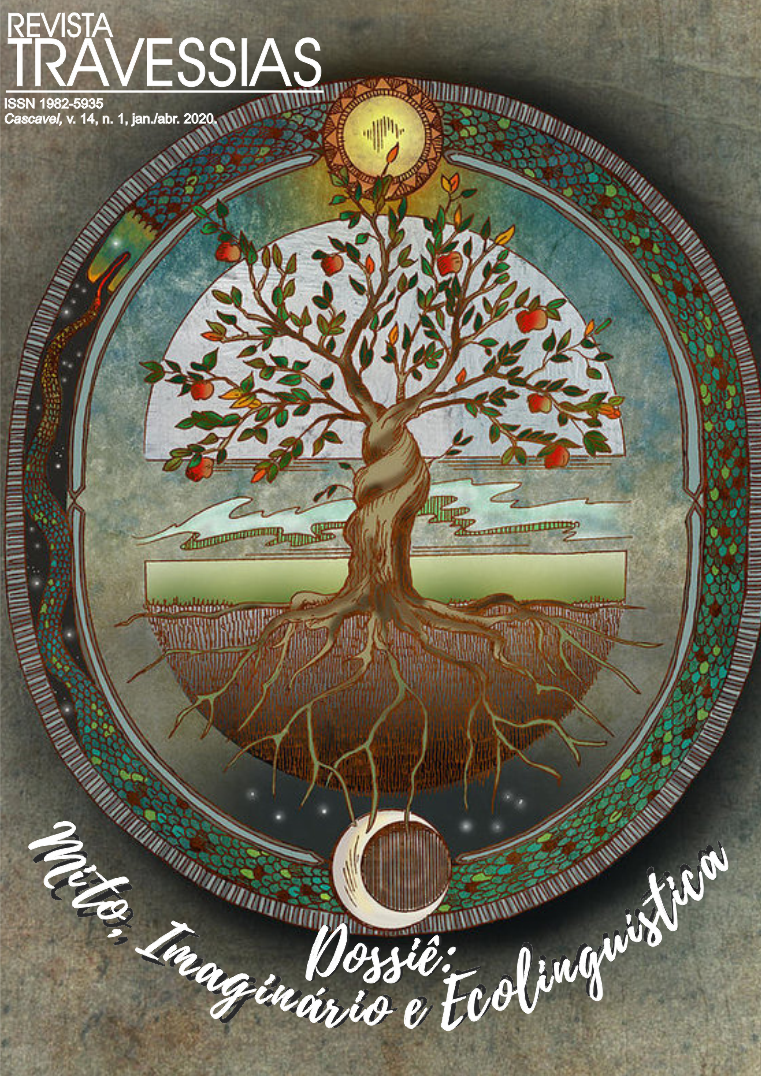Discurso de Bolsonaro na ONU, em 2019: a força dos mitemas e a verdade dos mitos
DOI:
https://doi.org/10.48075/rt.v14i1.24110Palavras-chave:
Imaginário, Mitocritica, Discurso, Meio ambiente.Resumo
Os discursos políticos e midiáticos contemporâneos acerca da percepção e da interação do ser humano com o meio ambiente apresentam conotações pouco claras sobre a preocupação com a sustentabilidade e com a manutenção da saúde do planeta. Diante dessa percepção e considerando que o homem só apreende a natureza por meio do símbolo, o objetivo dessa pesquisa é investigar como os aspectos simbólicos e míticos são mobilizados para construir os discursos recorrentes acerca da Amazônia. Analisaremos o discurso proferido por Bolsonaro na Assembleia-Geral da ONU, em setembro de 2019. A análise, fundamentada na mitocrítica (Gilbert Durand), aponta para o mito diretor de Maha-Maya ou Maya, a Deusa da Ilusão, no hinduísmo. O véu da ilusão perpassa o discurso do presidente brasileiro naquilo que diz respeito ao novo e ao ressurgimento do Brasil. No entanto, é preciso considerar que o ressurgimento traz um sentido de morte, desvelando o Deus Antaka – Yama -, o Deus da morte. O discurso do presidente vem permeado de um desejo de destruição para implementar um sonho pessoal, distante dos anseios da maioria da nação, desvelando as Erínias, o terceiro grupo das Deusas Cinzentas (além das Moiras e das Gréias), de nomes Aleto (a que nunca acaba), Tisífone (retaliação) e Megera (raiva); deusas que podem ser invocadas pelo nome de Erinis (espírito de cólera e de vingança); é possível dizer que na fala presidencial, em seu discurso proferido na ONU, ou nas suas apresentações cotidianas, inclusive no seu Twitter, há o sentido de vingança, retaliação e raiva.
Downloads
Referências
BROWN, Lester. Eco-Economia. Rio de Janeiro: EPI - Earth Policy Institute / UMA - Universidade Livre da Mata Atlântica, 2003.
CAPRA, Fritjof. As conexões ocultas: ciência para uma vida sustentável. Tradução: Marcelo Brandão Cipolla. São Paulo: Cultrix, 2003.
COUTO, Hildo H. do. A prefixação no crioulo guineense: desfazendo e refazendo ações. Revista internacional de linguística ibero-americana – RILI v. 1, n. 1, p. 161-174.
DURAND, Gilbert. Mito, Símbolo e Mitodologia. Tradução Hélder Godinho e Vitor Jabouille. Lisboa: Editorial Presença, s/d.
DURAND, Gilbert. Introduction à la mythodologie – mythes et sociétés. Paris: Albin Michel, 1996.
DURAND, Gilbert. Campos do Imaginário. Tradução: Maria José Batalha Reis. Lisboa: Instituto Piaget, 1998.
GREIMAS, A. J.; COURTÈS, J. [s/d]. Dicionário de Semiótica. Tradução: alceu Dias Lima; Edward Lopes; Maria José Castagnetti Sombra; Tieko Yamaguchi Myiazaki. 7ª ed. São Paulo: Contexto, 2008.
HILLMAN, James. O Código do Ser: uma busca do caráter e da vocação pessoal. Tradução: Adalgisa Campos da Silva. Rio de Janeiro: Objetiva, 1997.
KERÉNYI, Karl. A Mitologia dos Gregos – a história dos deuses e dos homens, v. I. Tradução: Octávio Mendes Cajado. Petrópolos, RJ: Editora Vozes, 2015.
LAFARGUE, Paul. 2019. A língua francesa antes e depois da Revolução. Ecolinguística: revista brasileira de ecologia e linguagem (ECO-REBEL) v. 5, n. 1, p. 46-84. Disponível em: https://periodicos.unb.br/index.php/erbel/article/view/22807/20551
LEVIS, C.; COSTA, F. R. C.; BONGERS, F.; PEÑA-CLAROS, M.; et al. Persistent effects of pre-Columbian plant domestication on Amazonian forest composition. Science. Vol. 355, Issue 6328, pp.925-931, 2017.
MATURANA, Humberto R. & VARELA, Francisco J. A Árvore do conhecimento: as bases biológicas da compreensão humana. Tradução: Humberto Mariotti e Lia diskin. São Paulo: Palas Athena, 2001.
MATURANA, Humberto. Emoções e Linguagem na Educação e na Política. Tradução: José Fernando Campos Fortes. Belo Horizonte, Editora UFMG, 2001.
MORIN, Edgar. O método 2: A vida da vida. Tradução: Marina Lobo. Porto Alegre: Editora Sulina, 2001.
ZIMMER, Heinrich. Mitos e Símbolos na arte e Civilização da Índia. Tradução: Carmen Fischer. São Paulo: Palas Athena, 1989.
Downloads
Publicado
Como Citar
Edição
Seção
Licença
Aviso de Direito Autoral Creative Commons
Política para Periódicos de Acesso Livre
Autores que publicam nesta revista concordam com os seguintes termos:
1. Autores mantêm os direitos autorais e concedem à revista o direito de primeira publicação, com o trabalho simultaneamente licenciado sob a Licença Creative Commons Attribution que permite o compartilhamento do trabalho com reconhecimento da autoria e publicação inicial nesta revista.
2. Autores têm autorização para assumir contratos adicionais separadamente, para distribuição não-exclusiva da versão do trabalho publicada nesta revista (ex.: publicar em repositório institucional ou como capítulo de livro), com reconhecimento de autoria e publicação inicial nesta revista.
3. Autores têm permissão e são estimulados a publicar e distribuir seu trabalho online (ex.: em repositórios institucionais ou na sua página pessoal) a qualquer ponto antes ou durante o processo editorial, já que isso pode gerar alterações produtivas, bem como aumentar o impacto e a citação do trabalho publicado (Veja O Efeito do Acesso Livre).
Licença Creative Commons
Esta obra está licenciada com uma Licença Creative Commons Atribuição-NãoComercial-CompartilhaIgual 4.0 Internacional, o que permite compartilhar, copiar, distribuir, exibir, reproduzir, a totalidade ou partes desde que não tenha objetivo comercial e sejam citados os autores e a fonte.



